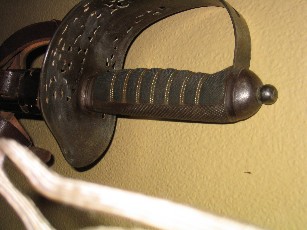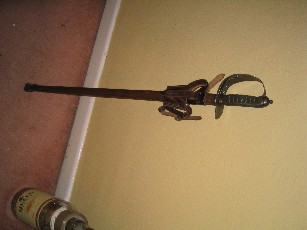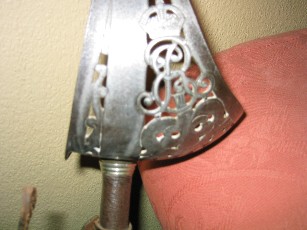Posts: 723 Location: Sweden
Sun 16 Nov, 2003 4:46 pm
What you have there is a British Infantry Officer's Sword, 1897 pattern. The blade pattern was introduced in 1891 and has not been changed to the present day. It is single-edged, apart from the last four inches at the point, where it has a back-edge as well. A 33 cm (13") long fuller runs on both sides, starting 5 cm (2") from the hilt. The last major change of the hilt of the infantry officers' sword was in 1895, when a completely new steel guard was adopted. It was a 3/4 basket hilt in plated sheet steel, with a 'scroll' pattern design in pierced strapwork, which also incorporates the royal cypher and crown. In 1897, the left or inner edge of the guard was modified so that it was 'turned down' to avoid the edge fraying the wearer's clothing, thus becoming the current 1897 pattern. The grip is 13 cm (5.1") long and covered with fishskin. This skin has the advantages of being both water resistant and tough, as well as providing a safe grip with its slightly rough surface. The grip is also wound with twisted metal wire. The back-piece has a washer for the riveted tang. The back of the grip is of chequered steel. In order to avoid rattling between the guard and the metal scabbard mouth, there's a thick buff leather washer at the base of the blade.
I notice that the sword-knot is missing. With its distinctive "acorn", it was a part of the sword, and was a wrist strap intended to avoid the loss of the sword in battle. At parades, the scabbard was replaced with one made in nickel-plated steel. The scabbard is of the Sam Browne pattern, introduced in 1899 in response to the need for a more practical scabbard for field use than the one made of steel. It is made of wood, with a metal scabbard mouth, and covered with brown leather. The "ferrule" is made of leather, too, and close to the scabbard mouth there's a leather strap attached. The strap is for the fastening in the belt frog supplied with the Sam Browne side belt.
Edward VII, son of Queen Victoria, was king between 1901 and 1910. If your sword is sharpened, it was most likely carried by an officer during World War 1. The type isn't uncommon, but it is nice to see that both the scabbard and belt-frog are still in good shape.
If the sword was made by Wilkinson (check the blade for stamps and serial number), it is possible to find records on the original owner.
http://www.wilkinson-swords.co.uk/
As for cleaning and care, stay on the safe side and don't overdo it. Here's a good article on the subject:
http://hometown.aol.com/machood/swordcare.html
Replacement sword knots can be found at
http://www.militaryheritage.com/knot.htm. You will want the "Universal Field Service Brown Leather Strap and Acorn".


